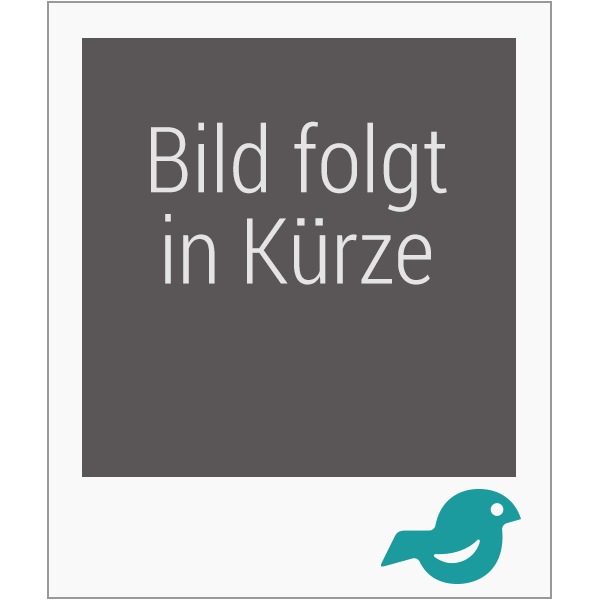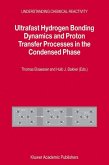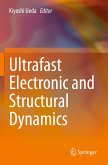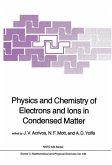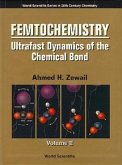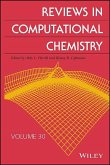Anatoly A Ischenko, Gennady V Fetisov, Sergey A Aseyev
Ultrafast Structural Dynamics of Free Molecules and Condensed Matter
Anatoly A Ischenko, Gennady V Fetisov, Sergey A Aseyev
Ultrafast Structural Dynamics of Free Molecules and Condensed Matter
- Gebundenes Buch
- Merkliste
- Auf die Merkliste
- Bewerten Bewerten
- Teilen
- Produkt teilen
- Produkterinnerung
- Produkterinnerung
The monograph is recommended for a wide range of readers interested in the problems of the structure of matter, ultrafast structural dynamics, including the study of the structure and dynamics of nanomaterials: scientists, graduate students and students specializing in this interesting and rapidly developing area.
Andere Kunden interessierten sich auch für
![Ultrafast Hydrogen Bonding Dynamics and Proton Transfer Processes in the Condensed Phase Ultrafast Hydrogen Bonding Dynamics and Proton Transfer Processes in the Condensed Phase]() Ultrafast Hydrogen Bonding Dynamics and Proton Transfer Processes in the Condensed Phase76,99 €
Ultrafast Hydrogen Bonding Dynamics and Proton Transfer Processes in the Condensed Phase76,99 €![Ultrafast Hydrogen Bonding Dynamics and Proton Transfer Processes in the Condensed Phase Ultrafast Hydrogen Bonding Dynamics and Proton Transfer Processes in the Condensed Phase]() ElsaesserUltrafast Hydrogen Bonding Dynamics and Proton Transfer Processes in the Condensed Phase78,99 €
ElsaesserUltrafast Hydrogen Bonding Dynamics and Proton Transfer Processes in the Condensed Phase78,99 €![Ultrafast Electronic and Structural Dynamics Ultrafast Electronic and Structural Dynamics]() Ultrafast Electronic and Structural Dynamics92,99 €
Ultrafast Electronic and Structural Dynamics92,99 €![Ultrafast Electronic and Structural Dynamics Ultrafast Electronic and Structural Dynamics]() Ultrafast Electronic and Structural Dynamics151,99 €
Ultrafast Electronic and Structural Dynamics151,99 €![Physics and Chemistry of Electrons and Ions in Condensed Matter Physics and Chemistry of Electrons and Ions in Condensed Matter]() Physics and Chemistry of Electrons and Ions in Condensed Matter229,99 €
Physics and Chemistry of Electrons and Ions in Condensed Matter229,99 €![Femtochemistry: Ultrafast Dynamics of the Chemical Bond - Volume II Femtochemistry: Ultrafast Dynamics of the Chemical Bond - Volume II]() Femtochemistry: Ultrafast Dynamics of the Chemical Bond - Volume II106,99 €
Femtochemistry: Ultrafast Dynamics of the Chemical Bond - Volume II106,99 €![Reviews in Computational Chemistry, Volume 30 Reviews in Computational Chemistry, Volume 30]() Reviews in Computational Chemistry, Volume 30293,99 €
Reviews in Computational Chemistry, Volume 30293,99 €-
-
-
The monograph is recommended for a wide range of readers interested in the problems of the structure of matter, ultrafast structural dynamics, including the study of the structure and dynamics of nanomaterials: scientists, graduate students and students specializing in this interesting and rapidly developing area.
Produktdetails
- Produktdetails
- Verlag: CRC Press
- Seitenzahl: 444
- Erscheinungstermin: 3. Dezember 2025
- Englisch
- ISBN-13: 9781041110842
- ISBN-10: 1041110847
- Artikelnr.: 74522239
- Herstellerkennzeichnung
- Libri GmbH
- Europaallee 1
- 36244 Bad Hersfeld
- gpsr@libri.de
- Verlag: CRC Press
- Seitenzahl: 444
- Erscheinungstermin: 3. Dezember 2025
- Englisch
- ISBN-13: 9781041110842
- ISBN-10: 1041110847
- Artikelnr.: 74522239
- Herstellerkennzeichnung
- Libri GmbH
- Europaallee 1
- 36244 Bad Hersfeld
- gpsr@libri.de
Prof., Dr. Sci. Anatoly A. Ischenko is a Head of the Department of Analytical Chemistry named after I. P. Alimarin of the Institute of Fine Chemical Technologies named after M. V. Lomonosov, MIREA-Russian Technological University, Moscow, Russian Federation. Main area of research: ultrafast processes in free molecules and condensed matter, chemical reaction dynamics and instrumental methods of analysis. In 1976-1977 was a scholar and in 1979 research associate at the electron diffraction laboratory at Oslo University, Norway and a long period of joint research work since 1992 with electron diffraction group at the University of Arkansas at Fayetteville, USA as invited professor. Published about 300 scientific papers, 7 monographs and 4 textbooks on analytical chemistry and instrumental methods of analysis for students of higher educational institutions and colleges; 29 patents for inventions. Have Russian and International awards for achievements in the field of Structural Chemistry and Nanotechnology. Prof., Dr. Sci. Gennady V. Fetisov is a Leading scientific researcher in the Laboratory of Structural Chemistry of the Department of Chemistry of Moscow State University named after M. V. Lomonosov, Moscow, Russian Federation. Main area of research: the development of new instrumental methods and experimental techniques for X-ray crystal structure analysis, including X-ray diffraction methods of crystal structure data collection for precision crystal structure analysis using laboratory and synchrotron radiation sources; studying structure of nanocrystals; methods for X-ray diffraction studies of crystals in external fields. Published about 100 scientific papers, 7 monographs and 4 textbooks on analytical chemistry and instrumental methods of analysis for students of higher educational institutions and colleges; 8 patents for inventions. Have Russian and International awards for achievements in the field of Materials Science, X-ray instrumentation and Nanotechnology. Prof., Dr. Sci. Sergei A. Aseyev is a Leading scientific researcher in the Laboratory of Laser Physics of the Institute of Spectroscopy of the Russian Academy of Sciences, Moscow, Russian Federation. Main area of research: femtosecond laser spectroscopy, ultrafast electron diffraction/microscopy, laser photoionization spectroscopy, attosecond photoelectron spectroscopy, projection microscopy. An original method of scanning microscopy with a hollow nanotip has been developed, which opened up the possibility of nanolocal photodesorption of molecular ions for studying organic structures with high spatial and high chemical elemental resolution. Photoelectron projection microscopy of organic nanostructures has been implemented. Published about 120 scientific papers, 4 monographs, 12 patents for inventions. Have Russian and International awards for achievements in the field of Ultrafast Spectroscopy.
Acknowledgements Foreword Chapter One Spectral methods for detecting dynamics of substances 1.1. Time-resolved optical spectroscopy 1.1.1. Time-resolved luminescence spectroscopy 1.1.2. Time-resolved difference absorption spectroscopy 1.1.3. Time-resolved Raman spectroscopy 1.1.4. Detection of laser-induced ultrafast processes in atomic-molecular structures 1.1.5. Intramolecular dynamics and the Born-Oppenheimer approximation 1.1.6. Ultrafast two-dimensional (2D) spectroscopy 1.1.7. Primary and stimulated photon echo 1.1.8. Progress in ultrafast laser spectroscopy 1.2. Attophysics 1.2.1. Angle-resolved attosecond photoelectron spectroscopy 1.2.2. Micro- and macroscopic aspects of the generation of high harmonics and ultrashort electromagnetic pulses of attosecond duration 1.3. Laser control of molecular degrees of freedom on a picosecond time scale 1.3.1. Optical molecular centrifuge: practical implementation and capabilities 1.3.2. Optical control of quantum rotors Conclusion References Chapter Two Dynamics of chemical reactions 2.1. Identification of photodissociation products by the TRXD signal at small X-ray scattering angles 2.2. Spectroscopic and structural study of molecular dynamics in an excited state by TRPES and UED methods Conclusion References Chapter Three Development of ultrafast electron microscopy 3.1. Examples in the field of UED 3.2. Detection of ultrafast coherent phenomena with UEM 3.2.1. UEM imaging of laser-induced phase transitions 3.2.2. UEM visualization of electromagnetic signals 3.2.3. Combining UEM with EELS (Electron Energy Loss Spectroscopy) 3.2.4. New trends in UEM: from 4D UEM to 5D UEM and attosecond electron microscopy 3.2.5. Holographic imaging of electromagnetic fields using electron-light quantum interference 3.2.6. UEM with laser nanoemitters 3.2.7. Ultrafast Lorentz Microscopy 3.3. Characterizing and controlling the out-of-equilibrium state of nanostructured Mott insulators Conclusion References Chapter Four Probing structural dynamics by ultra-short electron and X-ray pulses 4.1. Experimental setups for UEC 4.2. Diagnostics of the structural dynamics of condensed matter 4.2.1. Surfaces and crystals 4.2.2. Transition of graphite into diamond 4.2.3. Bilayers of the crystal structure of two-dimensional fatty acids: molecular assemblies 4.3. Photoswitching system changing properties from insulator to metal 4.4. Structural dynamics of nonequilibrium phase transitions 4.4.1. Vanadium dioxide 4.4.2. Superconducting cuprates 4.5. Quantum materials 4.5.1. Structural dynamics of quantum materials observed by UXRC, UXRnC and X-ray scattering methods 4.5.2. Structural dynamics of quantum materials observed by UXRC, UXRnC and X-ray scattering methods 4.5.3. "Anomalous" photoelectric effect in the UED method Conclusion References Chapter Five Methods for ultrafast electron and X-ray nanocrystallography 5.1. Time-resolved electron nano-crystallography 5.2. Basic Concepts 5.3. Sample preparation 5.4. Primary data processing 5.5. Some results of time resolved studies 5.5.1. Aluminum melting under tightly controlled conditions 5.5.2. Photoinduced heterogeneous changes in gold nanocrystals 5.5.3. Observation of coherent optical phonons excited by femtosecond laser radiation in Sb nanofilms 5.6. Time-resolved X-ray nanocrystallography 5.6.1. Spontaneous fluctuations and nanoscale heterogeneity 5.6.2. Structural dynamics of materials, energy transfer and phase transitions at the nanoscale 5.7. Nonequilibrium thermodynamics of colloidal gold nanocrystals Conclusion References Chapter Six Radiation sources and methods for ultrafast X-ray diffraction analysis 6.1. Processes studied by time resolved X-ray diffraction 6.2. Basics of X-ray Structure Analysis 6.3. Features of Time Resolved XRD (TRXRD) 6.3.1. Dynamics of slow processes-long-lived states 6.3.2. Short-lived states-dynamics of fast processes on a millisecond scale 6.4. The most important characteristics of instruments for X-ray diffraction studies of fast and ultrafast processes 6.4.1. The measures of radiation intensity 6.5. Synchrotron radiation 6.5.1. SR sources based on storage rings 6.5.2. Magnetic devices generating SR in storage rings 6.5.3. Classification of SR sources by generations 6.6. Free electron lasers - new sources of X-rays 6.6.1. Operating principles of free electron lasers 6.6.2. Examples of X-ray free electron lasers (XFELs) 6.7. Laser-plasma X-ray sources 6.7.1. Mechanisms of X-ray generation by laser plasma 6.7.2. Higher harmonics generation method 6.7.3. Hot laser plasma radiation 6.7.4. Laser-plasma accelerators and XFELs 6.8. Short-pulse X-ray generators based on inverse Compton scattering 6.8.1. Models of photon scattering by electrons 6.8.2. Inverse Compton effect - theoretical basis 6.8.3. On the duration of radiation pulses from laser-electron ICS sources and their polarization 6.8.4. Examples of operating ICS X-ray sources 6.8.5. Compton sources of X-rays based on FEL oscillators 6.8.6. ICS X-ray sources on linear electron accelerators 6.8.7. ICS X-ray sources based on small synchrotrons 6.8.8. Laser-plasma accelerators as X-ray generators 6.8.9. ICS X-ray sources with laser-plasma acceleration 6.8.10. Compact Compton X-ray sources 6.8.11. Examples of application of X-ray sources based on ICS 6.9. X-ray detectors for ultra-fast measurements 6.10. X-ray diffraction methods for studying structural dynamics using synchrotron, XFEL or ICS radiations 6.10.1. Experimental "pump-probe" methods 6.10.2. Stroboscopic measurements of diffraction patterns 6.10.3. Some problems in stroboscopic diffraction measurements by synchrotron radiation 6.10.4. Time-resolved diffraction studies using a laboratory diffractometer with an X-ray tube 6.10.5. Study of transition states in crystals using X-ray diffraction on synchrotron radiation 6.10.6. Problems of insufficient X-ray probe intensity in time-resolved XRSA 6.11. Time-resolved Laue X-ray diffraction for structure determination 6.12. SFXC - serial femtosecond X-ray crystallography 6.12.1. Sample delivery method for serial crystallography at XFEL 6.12.2. Data analysis using the SXC method 6.12.3. Improvements and modifications of X-ray diffraction analysis using the SXC method 6.12.4. Modifications of the SFXC method to SMXC 6.12.5. Practical application of SFXC Chapter Seven Visualization of structural dynamics in the femtosecond time domain: complementarity of spectroscopy and diffraction 7.1. Introduction 7.2. Transition State and Femtosecond Transition State Spectroscopy 7.3. Chemical dynamics via conical intersection between electronic states 7.4. Theory Elements of Time-Resolved Electron Diffraction 7.4.1. Basic assumptions and approximations 7.4.2. Aligned molecules 7.4.3. Solution of the inversion problem 7.4.4. The difference method for time-dependent diffraction data analysis 7.4.5. Time Dependent Diffraction from Single Crystals and Solution to the Inversion Problem 7.5. Dynamics of wave packets 7.5.1. Real time dynamics of transient states in photodissociation and photopredissociation 7.5.2. Quantum-dynamical simulations of photodissociation 7.6. The diffraction signatures of excited molecules 7.6.1. Molecular quantum state tomography 7.6.2. Non-adiabatic two-channel photo-dissociation of the CS
molecule 7.6.3. Diffraction signatures of aligned molecules 7.6.4. Photodissociation dynamics of aligned CS
and ICN molecules 7.7. Imaging the electrocyclic ring-opening reaction of 1,3-cyclohexadiene 7.7.1. The structure of the ground-state 1,3-cyclohexadiene molecule 7.7.2. Time-Resolved Electron Diffraction and Time-Resolved X-ray Diffraction of CHD 7.7.3. Convergence of Time-Resolved Electron and X-ray Diffraction, Femtosecond Spectroscopy and Quantum Chemistry 7.8. Dynamics of spectrally invisible structures 7.9. Photodissociation and ultrafast relaxation of iron pentacarbonyl 7.9.1. Ultrafast Electron Diffraction 7.9.2. Time-Resolved Femtosecond Spectroscopy and Mass-Spectrometry 7.9.3. Femtosecond-resolution Resonant Inelastic X-ray Scattering 7.10. Structure and nuclear dynamics in free radicals: the Jahn-Teller effect and pseudorotation in cyclopentadienyl radicals 7.11. Unimolecular photodissociation of 1,2-diiod-tetrafluoroethane 7.11.1. Structural dynamics of the elimination reaction of iodine atoms from the free C
F
I
molecules under collisionless conditions 7.11.2. Structural dynamics of iodine cleavage reaction in C
H
I
and C
F
I
molecules in solution 7.12. Laser-Induced Electron Diffraction 7.12.1. Ultrafast Electron Diffraction imaging of bond breaking in di-ionized acetylene 7.12.2. Molecular dynamics and electron density tomography 7.13. Atom Resolved Reaction Dynamics: Realization of the Chemists' Gedanken Experiment 7.14. Complementarity of spectroscopy and diffraction for studying structural dynamics 7.15. Theory: Closing the Loop 7.15.1. Short outline of computational techniques 7.15.2. Femtosecond quantum tomography: towards the quantum limit 7.16. Conclusions and future outlook Supplement References List of abbreviations index
molecule 7.6.3. Diffraction signatures of aligned molecules 7.6.4. Photodissociation dynamics of aligned CS
and ICN molecules 7.7. Imaging the electrocyclic ring-opening reaction of 1,3-cyclohexadiene 7.7.1. The structure of the ground-state 1,3-cyclohexadiene molecule 7.7.2. Time-Resolved Electron Diffraction and Time-Resolved X-ray Diffraction of CHD 7.7.3. Convergence of Time-Resolved Electron and X-ray Diffraction, Femtosecond Spectroscopy and Quantum Chemistry 7.8. Dynamics of spectrally invisible structures 7.9. Photodissociation and ultrafast relaxation of iron pentacarbonyl 7.9.1. Ultrafast Electron Diffraction 7.9.2. Time-Resolved Femtosecond Spectroscopy and Mass-Spectrometry 7.9.3. Femtosecond-resolution Resonant Inelastic X-ray Scattering 7.10. Structure and nuclear dynamics in free radicals: the Jahn-Teller effect and pseudorotation in cyclopentadienyl radicals 7.11. Unimolecular photodissociation of 1,2-diiod-tetrafluoroethane 7.11.1. Structural dynamics of the elimination reaction of iodine atoms from the free C
F
I
molecules under collisionless conditions 7.11.2. Structural dynamics of iodine cleavage reaction in C
H
I
and C
F
I
molecules in solution 7.12. Laser-Induced Electron Diffraction 7.12.1. Ultrafast Electron Diffraction imaging of bond breaking in di-ionized acetylene 7.12.2. Molecular dynamics and electron density tomography 7.13. Atom Resolved Reaction Dynamics: Realization of the Chemists' Gedanken Experiment 7.14. Complementarity of spectroscopy and diffraction for studying structural dynamics 7.15. Theory: Closing the Loop 7.15.1. Short outline of computational techniques 7.15.2. Femtosecond quantum tomography: towards the quantum limit 7.16. Conclusions and future outlook Supplement References List of abbreviations index
Acknowledgements Foreword Chapter One Spectral methods for detecting dynamics of substances 1.1. Time-resolved optical spectroscopy 1.1.1. Time-resolved luminescence spectroscopy 1.1.2. Time-resolved difference absorption spectroscopy 1.1.3. Time-resolved Raman spectroscopy 1.1.4. Detection of laser-induced ultrafast processes in atomic-molecular structures 1.1.5. Intramolecular dynamics and the Born-Oppenheimer approximation 1.1.6. Ultrafast two-dimensional (2D) spectroscopy 1.1.7. Primary and stimulated photon echo 1.1.8. Progress in ultrafast laser spectroscopy 1.2. Attophysics 1.2.1. Angle-resolved attosecond photoelectron spectroscopy 1.2.2. Micro- and macroscopic aspects of the generation of high harmonics and ultrashort electromagnetic pulses of attosecond duration 1.3. Laser control of molecular degrees of freedom on a picosecond time scale 1.3.1. Optical molecular centrifuge: practical implementation and capabilities 1.3.2. Optical control of quantum rotors Conclusion References Chapter Two Dynamics of chemical reactions 2.1. Identification of photodissociation products by the TRXD signal at small X-ray scattering angles 2.2. Spectroscopic and structural study of molecular dynamics in an excited state by TRPES and UED methods Conclusion References Chapter Three Development of ultrafast electron microscopy 3.1. Examples in the field of UED 3.2. Detection of ultrafast coherent phenomena with UEM 3.2.1. UEM imaging of laser-induced phase transitions 3.2.2. UEM visualization of electromagnetic signals 3.2.3. Combining UEM with EELS (Electron Energy Loss Spectroscopy) 3.2.4. New trends in UEM: from 4D UEM to 5D UEM and attosecond electron microscopy 3.2.5. Holographic imaging of electromagnetic fields using electron-light quantum interference 3.2.6. UEM with laser nanoemitters 3.2.7. Ultrafast Lorentz Microscopy 3.3. Characterizing and controlling the out-of-equilibrium state of nanostructured Mott insulators Conclusion References Chapter Four Probing structural dynamics by ultra-short electron and X-ray pulses 4.1. Experimental setups for UEC 4.2. Diagnostics of the structural dynamics of condensed matter 4.2.1. Surfaces and crystals 4.2.2. Transition of graphite into diamond 4.2.3. Bilayers of the crystal structure of two-dimensional fatty acids: molecular assemblies 4.3. Photoswitching system changing properties from insulator to metal 4.4. Structural dynamics of nonequilibrium phase transitions 4.4.1. Vanadium dioxide 4.4.2. Superconducting cuprates 4.5. Quantum materials 4.5.1. Structural dynamics of quantum materials observed by UXRC, UXRnC and X-ray scattering methods 4.5.2. Structural dynamics of quantum materials observed by UXRC, UXRnC and X-ray scattering methods 4.5.3. "Anomalous" photoelectric effect in the UED method Conclusion References Chapter Five Methods for ultrafast electron and X-ray nanocrystallography 5.1. Time-resolved electron nano-crystallography 5.2. Basic Concepts 5.3. Sample preparation 5.4. Primary data processing 5.5. Some results of time resolved studies 5.5.1. Aluminum melting under tightly controlled conditions 5.5.2. Photoinduced heterogeneous changes in gold nanocrystals 5.5.3. Observation of coherent optical phonons excited by femtosecond laser radiation in Sb nanofilms 5.6. Time-resolved X-ray nanocrystallography 5.6.1. Spontaneous fluctuations and nanoscale heterogeneity 5.6.2. Structural dynamics of materials, energy transfer and phase transitions at the nanoscale 5.7. Nonequilibrium thermodynamics of colloidal gold nanocrystals Conclusion References Chapter Six Radiation sources and methods for ultrafast X-ray diffraction analysis 6.1. Processes studied by time resolved X-ray diffraction 6.2. Basics of X-ray Structure Analysis 6.3. Features of Time Resolved XRD (TRXRD) 6.3.1. Dynamics of slow processes-long-lived states 6.3.2. Short-lived states-dynamics of fast processes on a millisecond scale 6.4. The most important characteristics of instruments for X-ray diffraction studies of fast and ultrafast processes 6.4.1. The measures of radiation intensity 6.5. Synchrotron radiation 6.5.1. SR sources based on storage rings 6.5.2. Magnetic devices generating SR in storage rings 6.5.3. Classification of SR sources by generations 6.6. Free electron lasers - new sources of X-rays 6.6.1. Operating principles of free electron lasers 6.6.2. Examples of X-ray free electron lasers (XFELs) 6.7. Laser-plasma X-ray sources 6.7.1. Mechanisms of X-ray generation by laser plasma 6.7.2. Higher harmonics generation method 6.7.3. Hot laser plasma radiation 6.7.4. Laser-plasma accelerators and XFELs 6.8. Short-pulse X-ray generators based on inverse Compton scattering 6.8.1. Models of photon scattering by electrons 6.8.2. Inverse Compton effect - theoretical basis 6.8.3. On the duration of radiation pulses from laser-electron ICS sources and their polarization 6.8.4. Examples of operating ICS X-ray sources 6.8.5. Compton sources of X-rays based on FEL oscillators 6.8.6. ICS X-ray sources on linear electron accelerators 6.8.7. ICS X-ray sources based on small synchrotrons 6.8.8. Laser-plasma accelerators as X-ray generators 6.8.9. ICS X-ray sources with laser-plasma acceleration 6.8.10. Compact Compton X-ray sources 6.8.11. Examples of application of X-ray sources based on ICS 6.9. X-ray detectors for ultra-fast measurements 6.10. X-ray diffraction methods for studying structural dynamics using synchrotron, XFEL or ICS radiations 6.10.1. Experimental "pump-probe" methods 6.10.2. Stroboscopic measurements of diffraction patterns 6.10.3. Some problems in stroboscopic diffraction measurements by synchrotron radiation 6.10.4. Time-resolved diffraction studies using a laboratory diffractometer with an X-ray tube 6.10.5. Study of transition states in crystals using X-ray diffraction on synchrotron radiation 6.10.6. Problems of insufficient X-ray probe intensity in time-resolved XRSA 6.11. Time-resolved Laue X-ray diffraction for structure determination 6.12. SFXC - serial femtosecond X-ray crystallography 6.12.1. Sample delivery method for serial crystallography at XFEL 6.12.2. Data analysis using the SXC method 6.12.3. Improvements and modifications of X-ray diffraction analysis using the SXC method 6.12.4. Modifications of the SFXC method to SMXC 6.12.5. Practical application of SFXC Chapter Seven Visualization of structural dynamics in the femtosecond time domain: complementarity of spectroscopy and diffraction 7.1. Introduction 7.2. Transition State and Femtosecond Transition State Spectroscopy 7.3. Chemical dynamics via conical intersection between electronic states 7.4. Theory Elements of Time-Resolved Electron Diffraction 7.4.1. Basic assumptions and approximations 7.4.2. Aligned molecules 7.4.3. Solution of the inversion problem 7.4.4. The difference method for time-dependent diffraction data analysis 7.4.5. Time Dependent Diffraction from Single Crystals and Solution to the Inversion Problem 7.5. Dynamics of wave packets 7.5.1. Real time dynamics of transient states in photodissociation and photopredissociation 7.5.2. Quantum-dynamical simulations of photodissociation 7.6. The diffraction signatures of excited molecules 7.6.1. Molecular quantum state tomography 7.6.2. Non-adiabatic two-channel photo-dissociation of the CS
molecule 7.6.3. Diffraction signatures of aligned molecules 7.6.4. Photodissociation dynamics of aligned CS
and ICN molecules 7.7. Imaging the electrocyclic ring-opening reaction of 1,3-cyclohexadiene 7.7.1. The structure of the ground-state 1,3-cyclohexadiene molecule 7.7.2. Time-Resolved Electron Diffraction and Time-Resolved X-ray Diffraction of CHD 7.7.3. Convergence of Time-Resolved Electron and X-ray Diffraction, Femtosecond Spectroscopy and Quantum Chemistry 7.8. Dynamics of spectrally invisible structures 7.9. Photodissociation and ultrafast relaxation of iron pentacarbonyl 7.9.1. Ultrafast Electron Diffraction 7.9.2. Time-Resolved Femtosecond Spectroscopy and Mass-Spectrometry 7.9.3. Femtosecond-resolution Resonant Inelastic X-ray Scattering 7.10. Structure and nuclear dynamics in free radicals: the Jahn-Teller effect and pseudorotation in cyclopentadienyl radicals 7.11. Unimolecular photodissociation of 1,2-diiod-tetrafluoroethane 7.11.1. Structural dynamics of the elimination reaction of iodine atoms from the free C
F
I
molecules under collisionless conditions 7.11.2. Structural dynamics of iodine cleavage reaction in C
H
I
and C
F
I
molecules in solution 7.12. Laser-Induced Electron Diffraction 7.12.1. Ultrafast Electron Diffraction imaging of bond breaking in di-ionized acetylene 7.12.2. Molecular dynamics and electron density tomography 7.13. Atom Resolved Reaction Dynamics: Realization of the Chemists' Gedanken Experiment 7.14. Complementarity of spectroscopy and diffraction for studying structural dynamics 7.15. Theory: Closing the Loop 7.15.1. Short outline of computational techniques 7.15.2. Femtosecond quantum tomography: towards the quantum limit 7.16. Conclusions and future outlook Supplement References List of abbreviations index
molecule 7.6.3. Diffraction signatures of aligned molecules 7.6.4. Photodissociation dynamics of aligned CS
and ICN molecules 7.7. Imaging the electrocyclic ring-opening reaction of 1,3-cyclohexadiene 7.7.1. The structure of the ground-state 1,3-cyclohexadiene molecule 7.7.2. Time-Resolved Electron Diffraction and Time-Resolved X-ray Diffraction of CHD 7.7.3. Convergence of Time-Resolved Electron and X-ray Diffraction, Femtosecond Spectroscopy and Quantum Chemistry 7.8. Dynamics of spectrally invisible structures 7.9. Photodissociation and ultrafast relaxation of iron pentacarbonyl 7.9.1. Ultrafast Electron Diffraction 7.9.2. Time-Resolved Femtosecond Spectroscopy and Mass-Spectrometry 7.9.3. Femtosecond-resolution Resonant Inelastic X-ray Scattering 7.10. Structure and nuclear dynamics in free radicals: the Jahn-Teller effect and pseudorotation in cyclopentadienyl radicals 7.11. Unimolecular photodissociation of 1,2-diiod-tetrafluoroethane 7.11.1. Structural dynamics of the elimination reaction of iodine atoms from the free C
F
I
molecules under collisionless conditions 7.11.2. Structural dynamics of iodine cleavage reaction in C
H
I
and C
F
I
molecules in solution 7.12. Laser-Induced Electron Diffraction 7.12.1. Ultrafast Electron Diffraction imaging of bond breaking in di-ionized acetylene 7.12.2. Molecular dynamics and electron density tomography 7.13. Atom Resolved Reaction Dynamics: Realization of the Chemists' Gedanken Experiment 7.14. Complementarity of spectroscopy and diffraction for studying structural dynamics 7.15. Theory: Closing the Loop 7.15.1. Short outline of computational techniques 7.15.2. Femtosecond quantum tomography: towards the quantum limit 7.16. Conclusions and future outlook Supplement References List of abbreviations index

